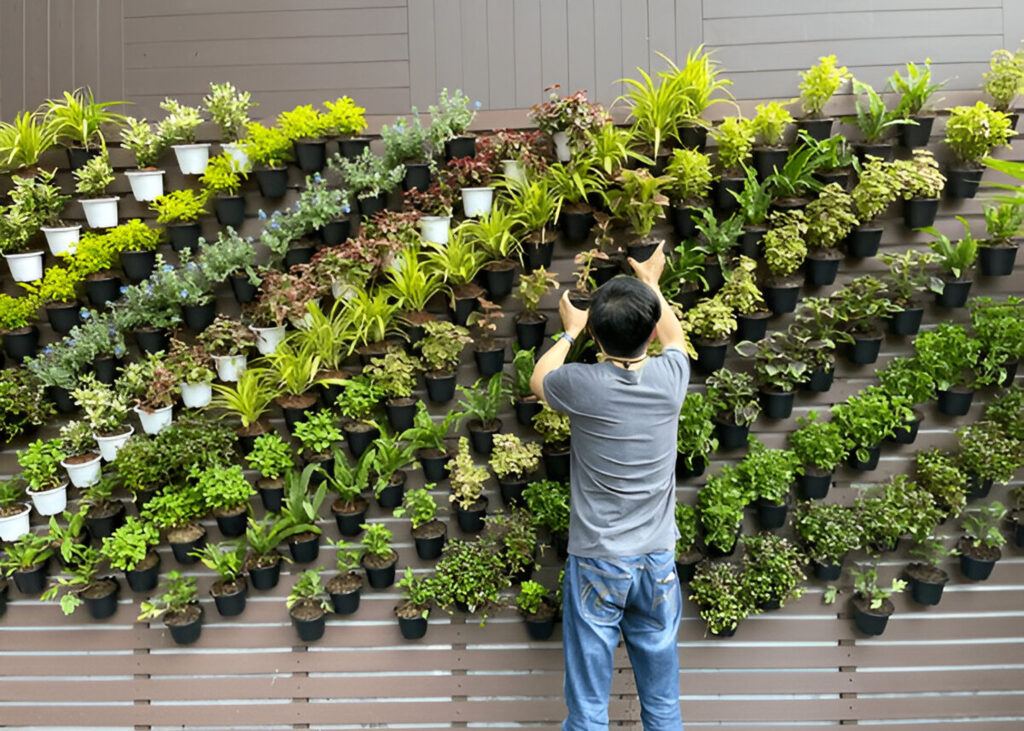Breathe New Life into Your Space: The Benefits of Vertical Gardening
- 08-01-2025
- By Vaishnavi B
Introduction:
The lack of vegetation in urbanized areas, as a result of human establishments, directly affects the quality of life from a physical and aesthetic point of view. The construction of vertical gardens is recommended both in interiors and especially in the exteriors of buildings. By applying these technologies, any kind of area can be used at its maximum capacity, obtaining esthetic valences, which are beneficial for the environment and human health. Even if the price of constructing and maintaining the vertical gardens is higher than a classical landscape, it’s compensated by the environmental benefits, raising the vegetation surfaces, with an impact for reducing the pollution effect. The new modern concepts for landscape development are keen on using any kind of concrete or glass, turning them into real vertical gardens, being possible to overcome the development of the urban areas, making a smooth transition for a healthy green urban environment.
Why Vertical Gardening is Trending
Vertical gardening is trending due to its ability to make efficient use of vertical spaces, making it ideal for urban areas where ground space is limited. This gardening method involves growing plants upwards on walls, trellises, or specially designed structures. It not only maximizes space but also adds an attractive and unique element to buildings and other commercial properties.
Vertical gardening is a special kind of urban gardening suitable for small spaces, particularly for decorating the walls and roofs in various styles. This is an alternative method for gardening by expanding the scope of growing plants in a vertical space. Intensive urbanization has left hardly any horizontal space for outdoor gardens. Green walls are not only spectacularly beautiful but also helpful in enlivening the ambiance. Green walls can absorb heated gas in the air, lowering both indoor and outdoor temperatures, providing a healthier indoor air quality as well as a more beautiful space.
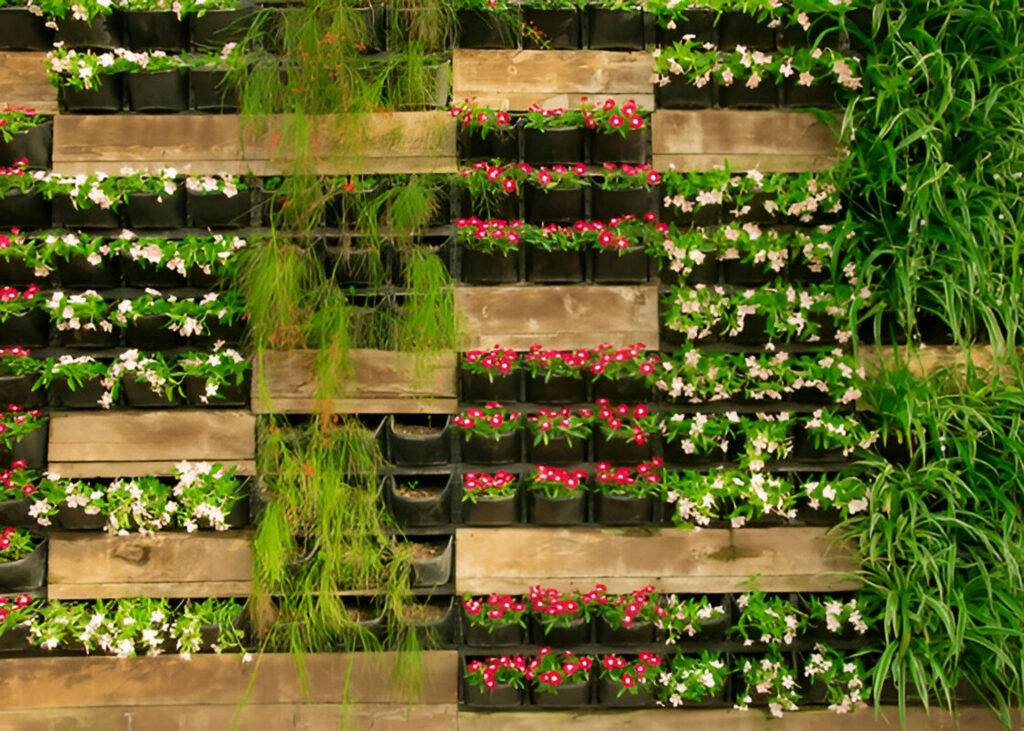
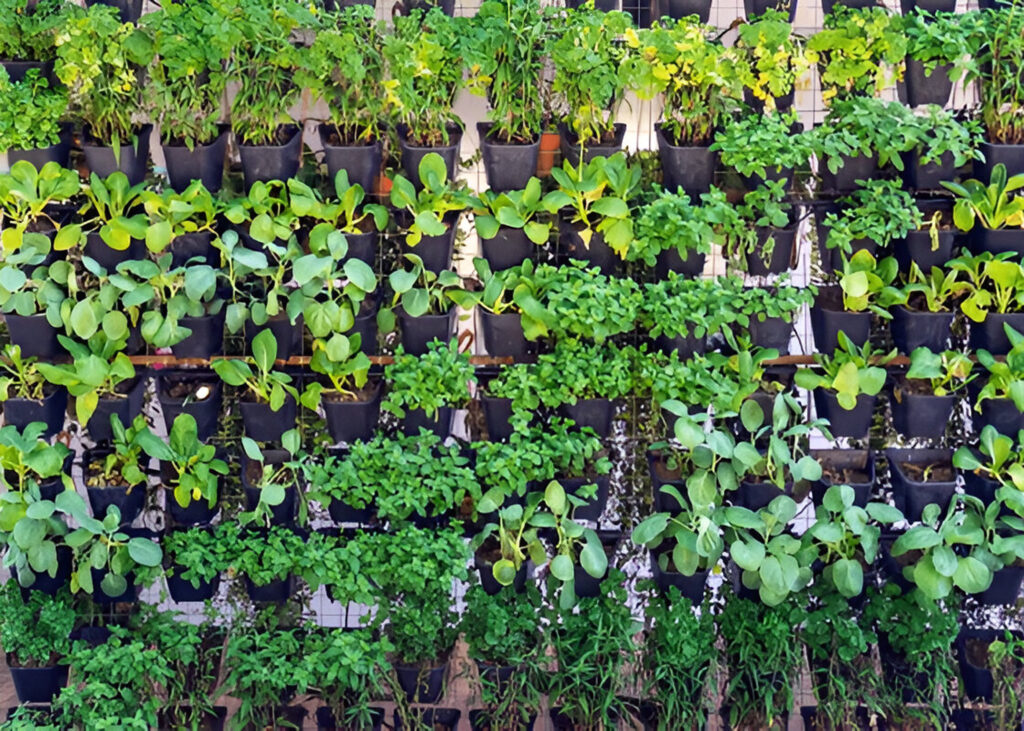
Types of vertical greening system:
1.Green facade
2.Living/green wall
i) Modular green walls
ii)Vegetated mat wall
Green facades:
- Green facades are a type of green wall system in which climbing plants or cascading groundcovers are trained to cover specially designed supporting structures.
- Plants are either grown in the ground or in the elevated containers where they are watered and fertilized.
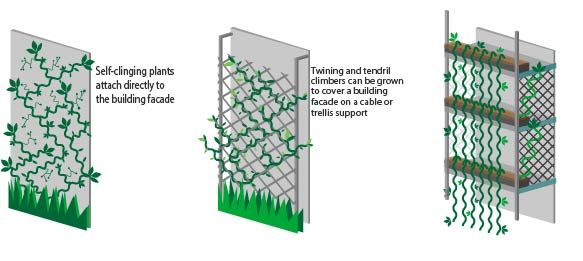
Green facades are a type of green wall system in which climbing plants or cascading groundcovers are trained to cover specially designed supporting structures. Rooted at the base of this structure, in the ground, in intermediate planters, or even on achieving full coverage. Green facades can be anchored to existing walls or built as freestanding structures, such as fences or columns.
Living walls / Green walls:
Living wall system composed of pre-vegetated panels, vertical modules, or planted blankets that are fixed vertically to a structural wall or frame. These panels can be made of plastic, expanded polystyrene, or synthetic fabric and support a great diversity of plant species (e.g., a lush mixture of ferns, ground covers, perennials, and edible plants).
Constructed from pre-vegetated panels, vertical modules, or planted blankets (vegetated mat walls) that are fixed to structural frameworks or to a wall made from steel framework, plastic, expanded polystyrene, and synthetic fabric to support a variety of diversity and density of plant species. Tend to require more maintenance, such as fertilizer and water, than green facade systems that are planted into the ground.
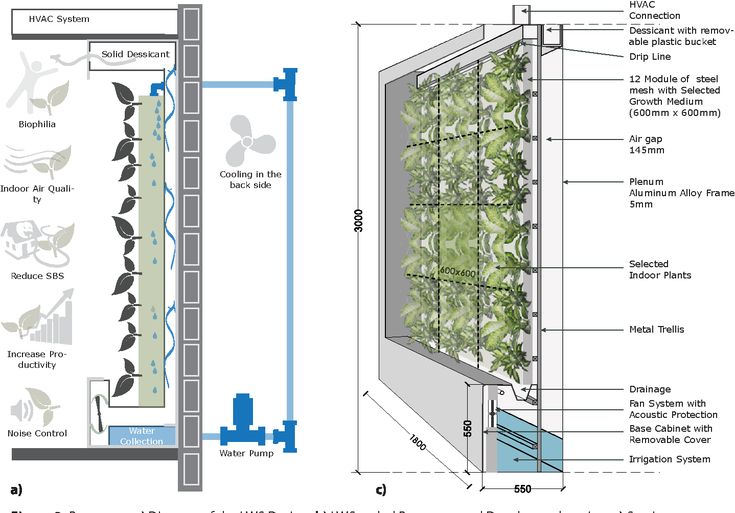
Modular green wall:
Vertical garden modules are made up of recycled polypropylene material. It has an attractive look, is highly durable in nature, and it can be easily installed. It provides an instant solution for making a garden in your residing place.
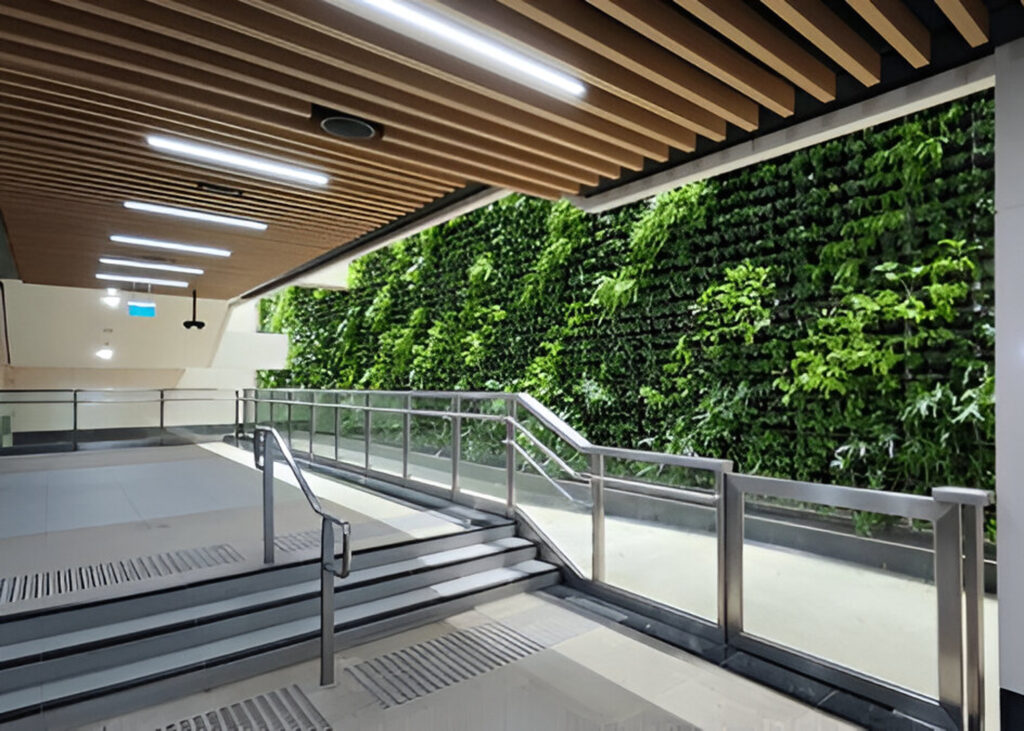
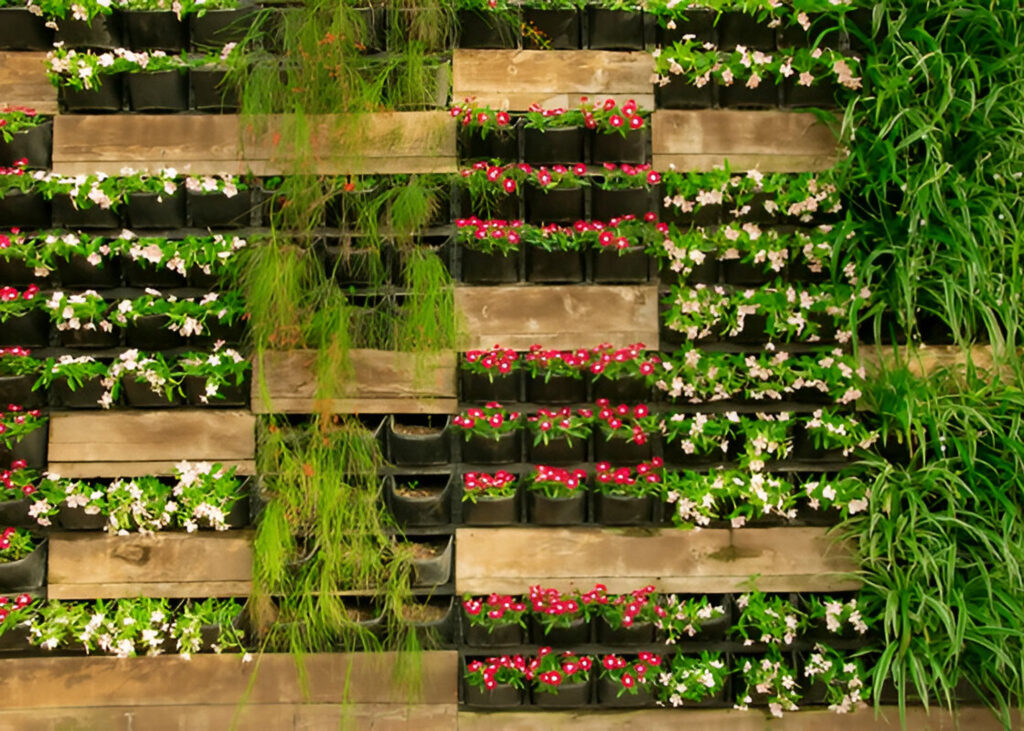
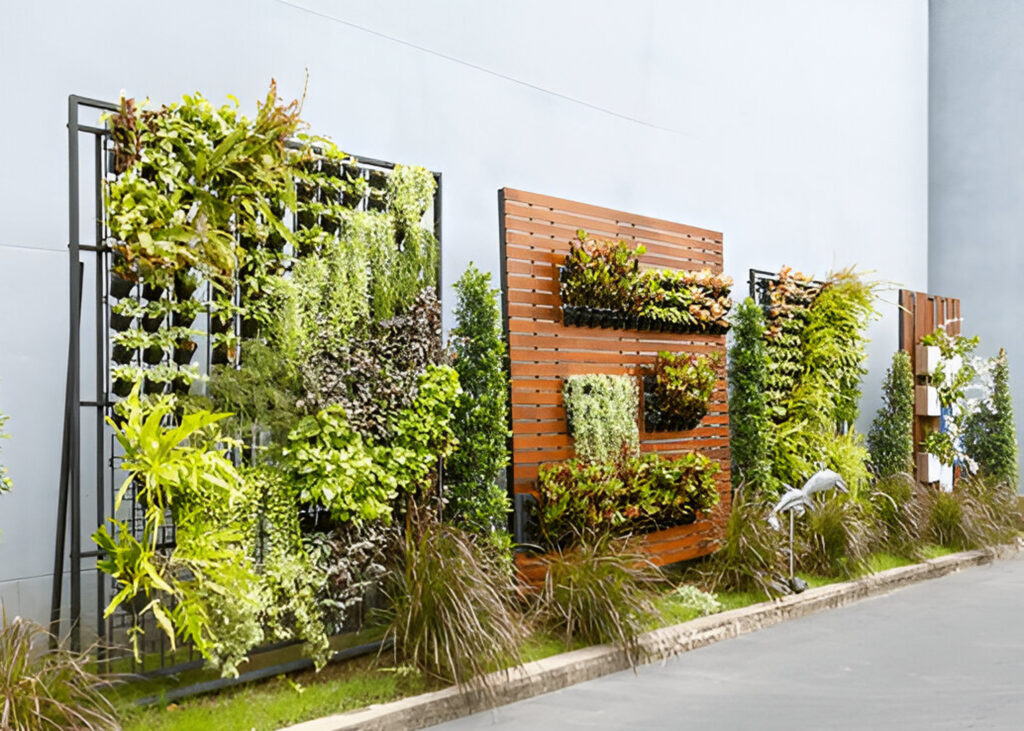
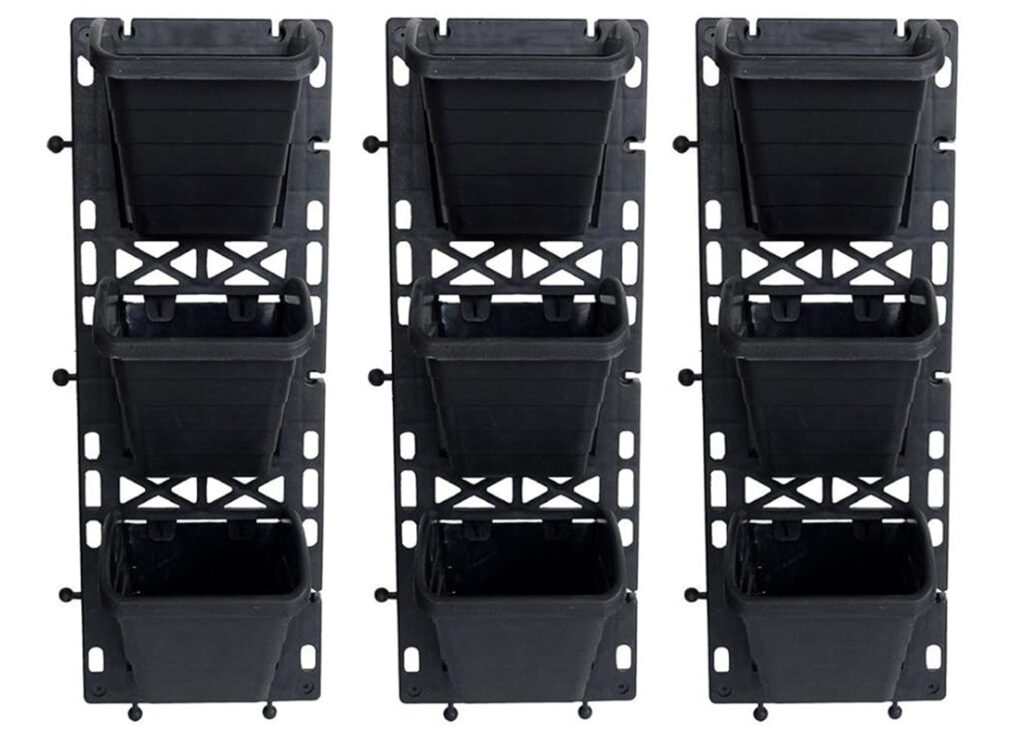
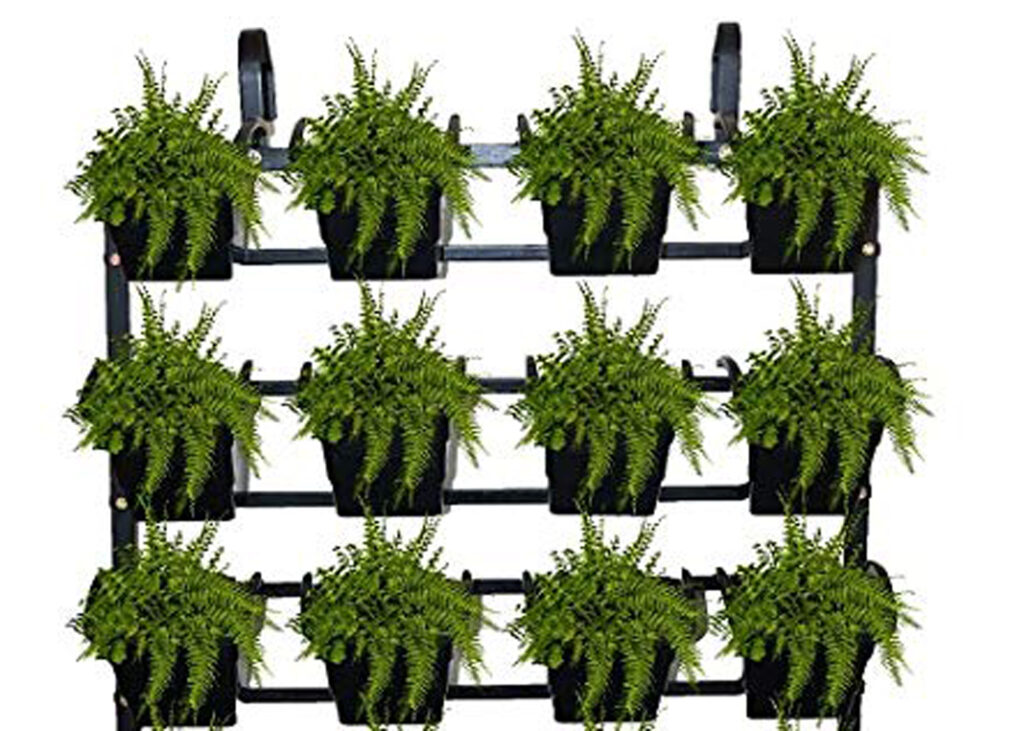
Vegetated mat wall :
This system, pioneered by Patrick Blanc, is composed of two layers of synthetic fabric with pockets filled with the plants and growing media. The fabric walls are supported on a framework and backed by a waterproof membrane against the building wall. Nutrients and water are delivered through an irrigation system at the top of the wall.
Structures and components for green wall system:
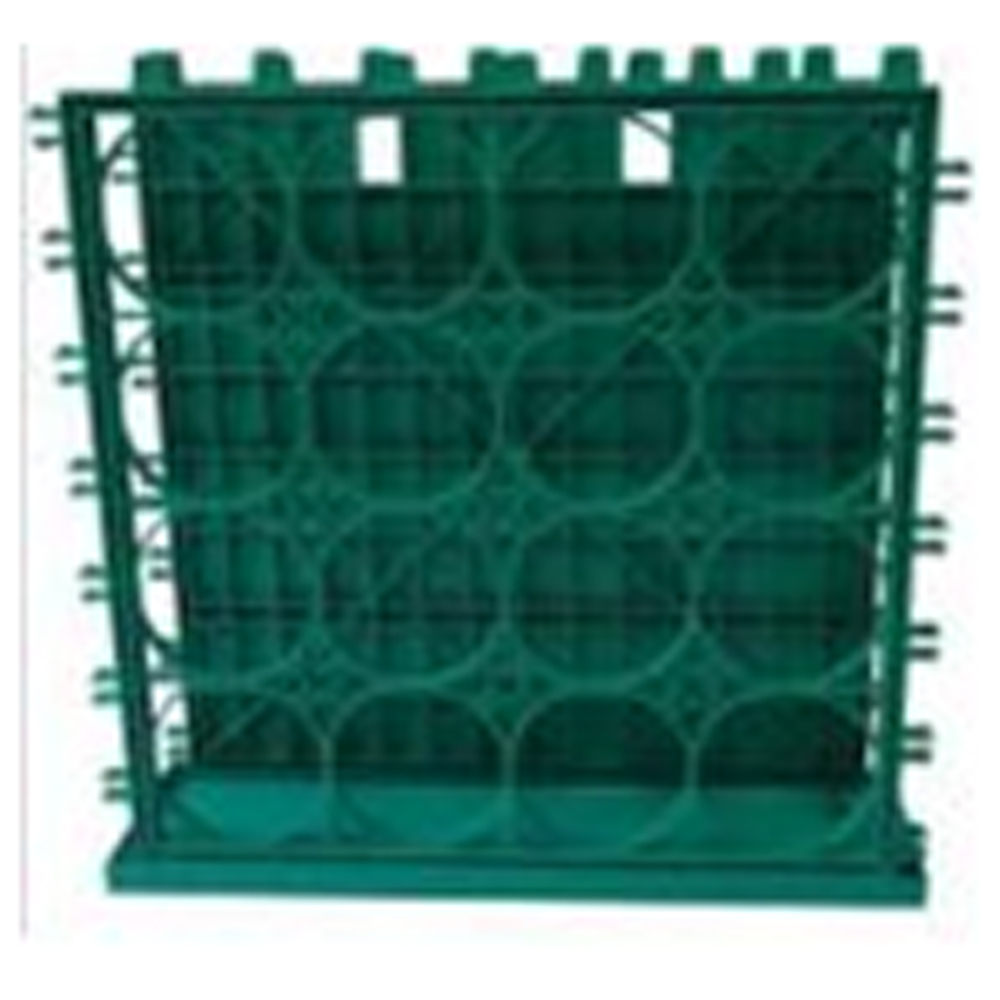
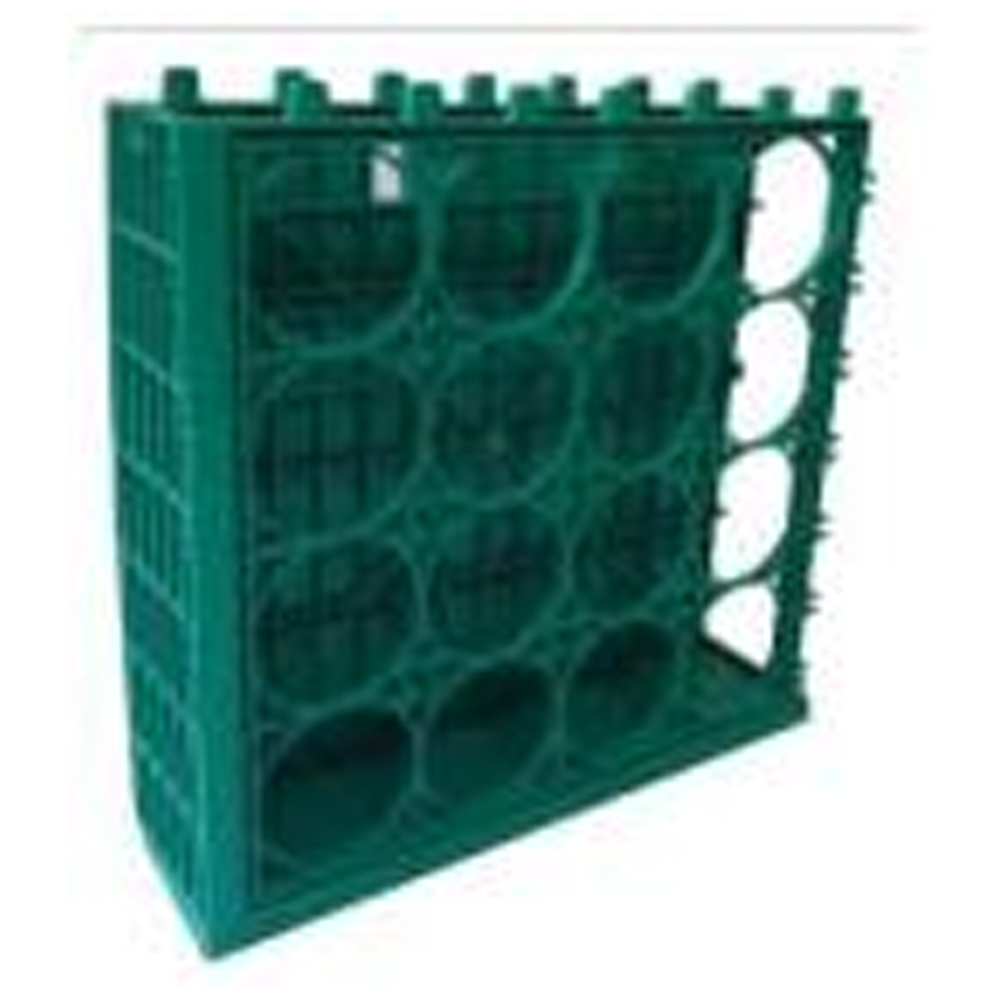
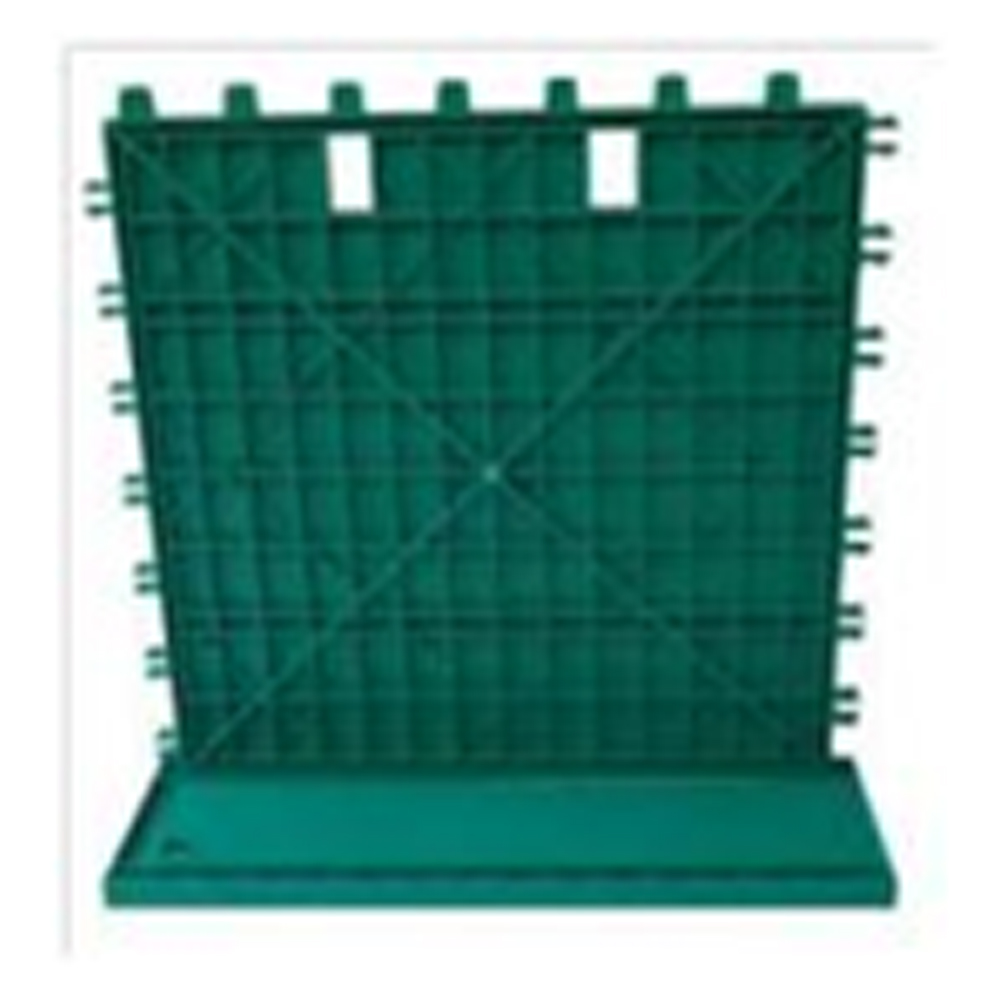
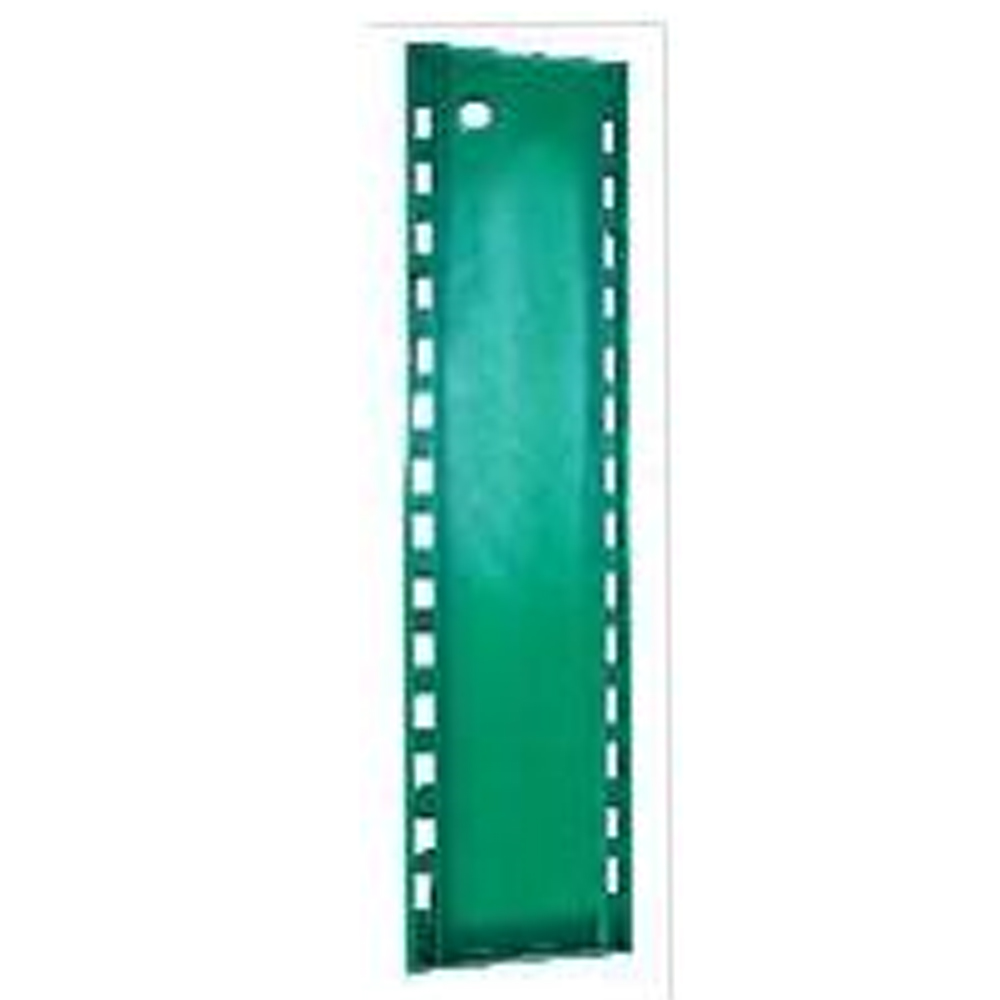
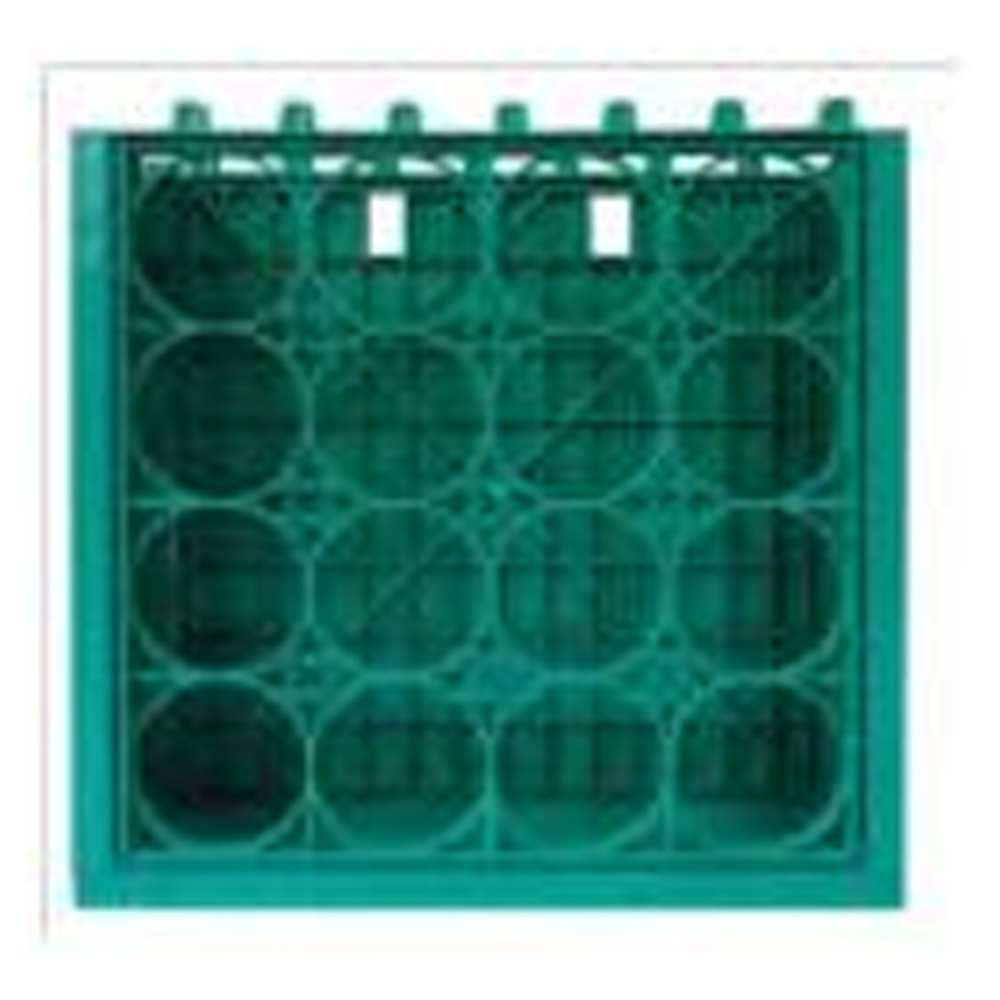
Choosing the plants :
The best plants for vertical gardens are dense, compact, and low-growing. Make sure you choose species that suit the aspect of the wall on which they’ll be growing. A wall drenched in sun, for instance, will need a selection of fairly drought-tolerant plants, whereas a shady spot—perhaps under a pergola or verandah—will require a selection of shade lovers, such as ferns. Also bear in mind that the bottom of the unit will hold more moisture than the top, so consider this when you’re deciding what to plant where.
Apart from aesthetic preferences and the plant’s ability to grow in a soilless, vertical location, the selection of plants is based on several factors, for example: What is the local climate like (minimum temperature especially important to know)? How much sun exposure is each area of the surface receiving, and how does it change during the year? Is there any particular microclimate—such as high buildings creating strong winds along a wall? Understanding the prevailing growing conditions is essential to make the right decision when choosing plants.
Plants suitable for vertical garden :
Outdoor plants Peperomia, Syngoniums, Philodendron, Epipremnum, Begonia, Anthuriums, Nephrolepis, Chlorophytum, Lantana, Rheo discolor, Cuphea, Fittonia, Spathiphylum, Schefflera
Indoor Green walls/ For shaded areas:
Herbaceous perennials | Pepromia, Syngoniums, Philodendron, Epipremnum, Pepromia, Begonia, Anthuriums, Chlorophytum, Rheo discolor, Fittonia, Spathiphylum, Schefflera |
Shrubs | Schefflera, Ficusspp |
succulents | Rheo discolor, Zebrinapendula, Setcreaseapurpurea |
Ferns | Nephrolepis |
For Outdoors/Exterior Green walls:
Herbaceous perennials | Asparagus spp, Pileamicrophylla, Alternenthera, Mentha spp. |
Succulents | Jade plant, Sedums, Portuluca |
Shrubs | Dusty miller, Cuphea |
Ground covers | Baby’s tear, Callisarepens |
Grass like foliage forms | Ophiophogon, Dianellatasmanica |
Requirements:
- Weightless media
- High Water holding capacity
- High Nutrient holding capacity
- Good Porosity
- Neutral pH
Cocopeat, Perlite, Sphagnum moss, vermiculite, vermicompost, shredded bark and leaf molds are the common media combinations used. Soil in not used since it increases the weight of the green walls.
There are three types of growth media used in living walls:
- Loose media
- Mat media
- Structural media.
Loose medium:
Walls tend to be “soil-on-a-shelf” or “soil-in-a-bag” type systems. Loose medium systems have their soil packed into a shelf or bag and then are installed onto the wall. These systems require their media to be replaced at least once a year on exteriors and approximately every two years on interiors. Loose soil systems are not well suited for areas with any seismic activity. Reparations are only achieved by re-stuffing soil into the holes on the wall, which is both difficult and messy. Loose-soil systems should not be used in areas where there will be a lot of public interaction as they are quite messy and lose their soil little by little over time. Loose-soil systems with physical media erosion systems are well suited for all green wall applications.
Mat type systems:
Tend to be either coir fiber or felt mats. Mat media are quite thin, even in multiple layers, and as such cannot support vibrant root systems of mature plants for more than three to five years before the roots overtake the mat and water is not able to adequately wick through the mats. The method of reparation of these systems is to replace large sections of the system at a time by cutting the mat out of the wall and replacing it with new mat. This process compromises the root structures of the neighboring plants on the wall and often kills many surrounding plants in the reparation process.
Structural media:
Structural media are growth medium “blocks” that are not loose, nor mats, but incorporate the best features of both into a block that can be manufactured into various sizes, shapes and thicknesses. These media have the advantage that they do not break down for 10 to 15 years, can be made to have a higher or lower water holding capacity depending on the plant selection for the wall, can have their pH and EC’s customized to suit the plants, and are easily handled for maintenance and replacements. They are the most robust option for a living wall for both exterior applications and for interior applications. They are also the best choice in areas where high-winds, seismic activity or heights need to be addressed in the design. Structural media are superior to the other media for their longevity and high-level of performance in a variety of circumstances. Depending on the installation, they do tend to be more expensive to install, but lower cost to maintain.
Irrigation and plant nutrition:
Green walls cannot be sustained without irrigation. Interruptions to the water supply are a common cause of plant failure on green walls. Systems designed with inbuilt irrigation should mitigate plant losses due to inconsistent moisture management, although errors can still occur. Automated, remotely controllable irrigation systems are used for walls in high-profile locations or in situations where access is challenging. Note that the quality, design, and costs will vary between different systems. The most sophisticated systems enable the maintenance supervisor to keep track of the automated performance of the system, including the volume of irrigation delivered, its frequency, substrate moisture content, as well as pH and nutrient levels in the water supply. The settings can be overridden if needed; for instance, the frequency or duration of irrigation cycles may be increased on hot days. In hydroponic systems, plant nutrition is delivered by a fertilizer injection system that releases controlled doses of fertilizer into the irrigation system (fertigation). Management of fertigation systems and rates of delivery requires specialist knowledge, as it is more complex than fertilizing soil or growing media. Hydroponic systems require continual monitoring of pH, water hardness, and total dissolved solids (TDS) and adjustment of these parameters where necessary.
Irrigation:
The irrigation system is designed to minimize water consumption. It consists of an automation unit with equipment for control of nutrient injection and irrigation cycles. When a surface has a variation of sun exposures, the irrigation is divided into segments in order to program it specifically for each part. Within the multi-layered felt surface, a drip tube is integrated. Water consumption varies with heat and sun exposure, but compared to normal green spaces or a lawn, the consumption is normally lower.
It averages between 2-5 l/m2/day.
For hydroponic green wall systems, the fertigation system may apply 0.5-20 litres of irrigation solution per square metre per day. Internal green wall requirements are at the lower end of this range, and external green walls are at the higher end. Irrigation cycles typically last a few minutes and will be required several times a day. Keeping irrigation volumes low minimizes waste and reduces run-off. Irrigation runoff may be captured in a tank at the base of the wall and recycled back through the green wall system. Green walls that use a high-quality, water-retentive growing medium and are not in an exposed or particularly hot location may thrive on a weekly watering regime. In most simple, soil-based systems, including DIY systems, controlled-release fertilizer is mixed in with the growing medium, rather than using a fertigation system. Irrigation must be available as soon as the plants are installed in the wall system. The irrigation system requires a water meter to monitor irrigation volume and a pressure gauge to monitor the even application of water. The need for ongoing regular irrigation and the expectation that water will be used sustainably mean that stored (harvested or recycled) water should be used whenever possible, so a pump is necessary.
Design / process:
Each vertical garden is given a unique design and selection of species. The composition of plants takes into consideration the specific environment where it will be built, such as the local and microclimate, sun exposure, and the surrounding context. The aim is to create a one-of-a-kind and site-specific garden that stands beautiful through all the seasons of the year.
A well-executed design is also a way to minimize the future maintenance demand of the garden. A plant’s growth habit, size, and behavior on a vertical surface are important knowledge for making the right combination of species in order to keep the competition between plants at a healthy level. Choosing the right plant for the right place makes sense for any garden, but maybe even more so in a vertical garden.
A vertical garden can be installed in almost any location, and as a living material, the potential of integrating plants in our urban environments is interesting. Places never thought of as possible could be inhabited by plants, like subway stations or other intensely frequented places where horizontal space is difficult to spare.
Light:
Direct sunlight can deliver over 100,000 lux, whereas the average light level in an office is around 300-500 lux. Even if the least light-demanding species are used, artificial light is normally necessary indoors. A few species will stay fine at 900 lux, but a slightly increased level at some parts of the surface will broaden the variation of species that can be used. An artificially illuminated surface has shifting light levels due to the fact that light reduces with the square of the distance from the light source. Some areas might have 3,000 lux and others 900 lux. The plant design is made with this in mind, taking advantage of the higher levels for more demanding and interesting species.
General considerations:
- Watering: Appropriate time
- Careful selection for wind-prone areas (Succulent and hardy plants)
- Removing the dried leaves
- Keeping the structure clean
- Disposing of the water from the drainage system
- Pruning if necessary
- Timely application of fertilizers
Benefits of Vertical Gardening:
- Aesthetic effects
- Acts as natural insulation for hot and cold air and saves energy for your building
- Reduces CO2 levels increases oxygen and improves air quality
- Conserves water and watering takes less effort
- Sound absorption and noise absorption
- Improves thermal insulation and energy efficiency
- Protects buildings from adverse temperatures and hence improves the life expectancy of the buildings
- Mitigate urban island heat effect
Steps for installation
As you know, our system can be installed on a wall or Metal structure If you are considering installing on a wall metal structure, it is recommended to have a basic metal framing done using an Aluminium profile on the wall.
- This framing of the Aluminium profile creates a Barrier between the wall & the panels. This ensures that your wall will not get damaged due to watering & in addition, this will ensure a less no of holes are drilled into your wall.
- Once the Aluminium profiling is done the wall frames are attached to the Aluminium profile with the help of a drilling machine and using self–drilling screws.
- Once the frames are attached, the pots are connected to the frames by presenting hard on the back portion of the pot & tilting & attaching to the frame.
- About caps watering –watering to the plants installed in the Greenwall system can be given using Drip Irrigation or through manual watering using a hose pipe, or watering can on a spray pump. it is recommended to have a drip irrigation system if the area is more than 50sq.ft or the Height of the wall is more than 6ft. It holds rainwater, providing food and shelter for wildlife.
Or you can use garden trellis/nets to hand the pots to form a low cost vertical gardens.
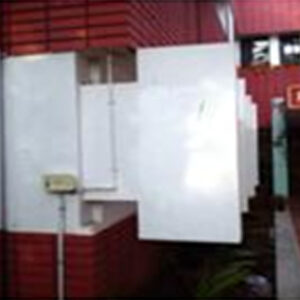
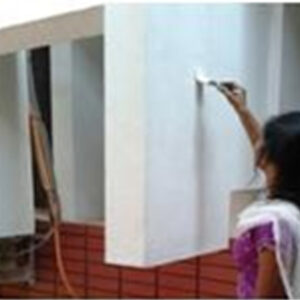
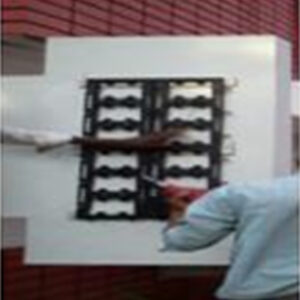
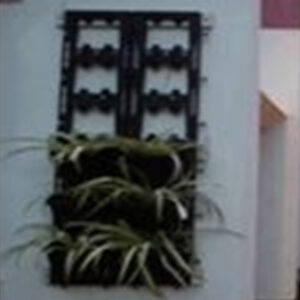
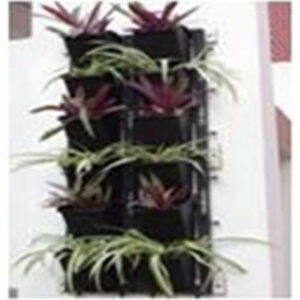
Green walls in various locations:
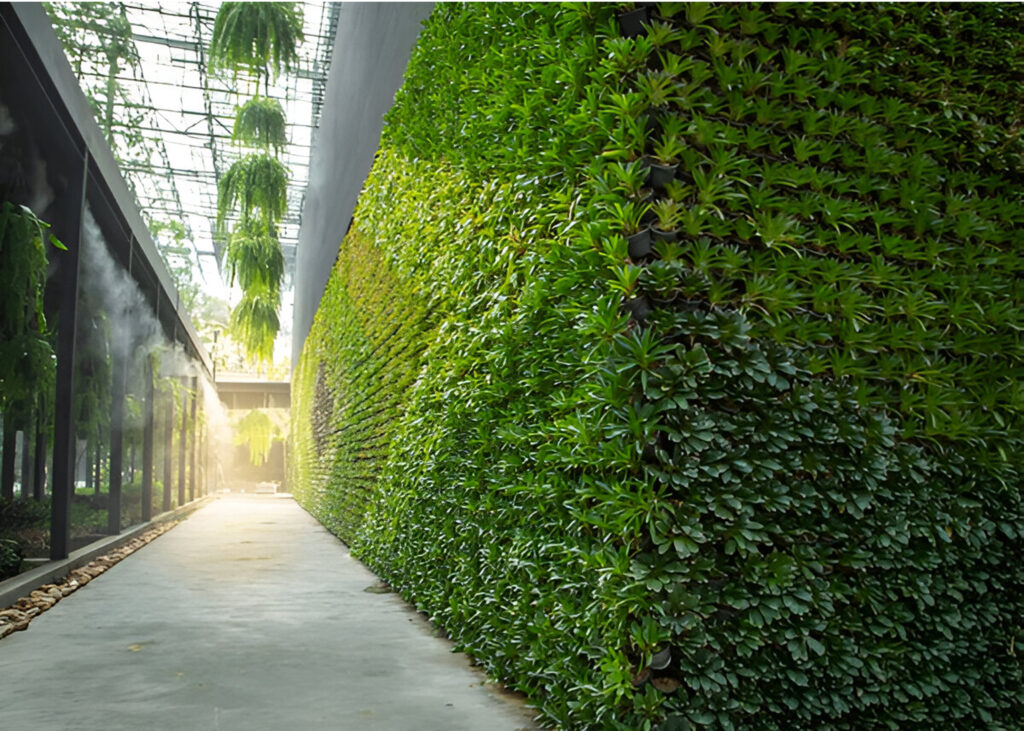
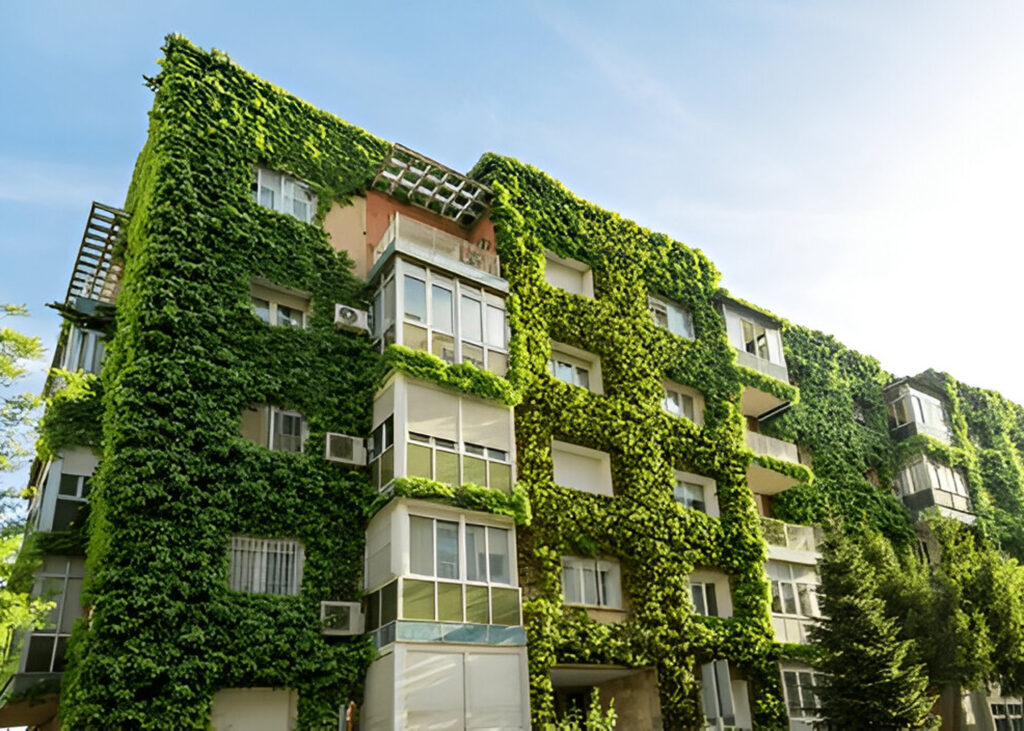
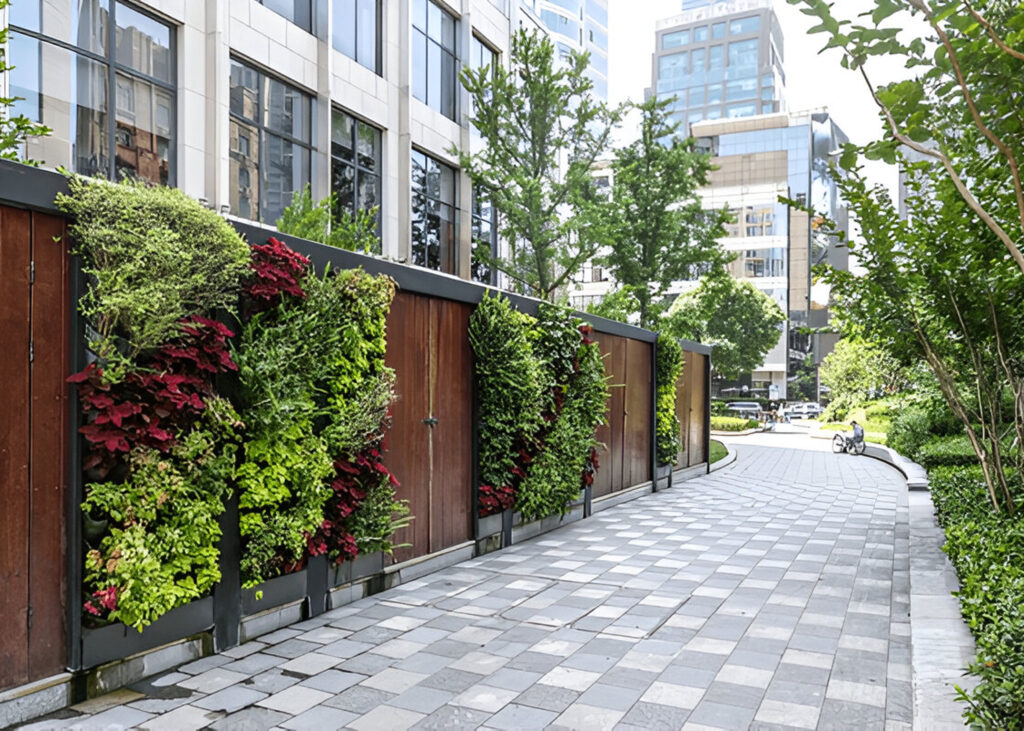
Planning outdoor recreation: Expert perspectives on landscape
We help turn your visions into reality with personalized landscaping solutions that speak to your personal style. Be it a beautiful flowerbed or a cozy patio, we guide you through every step to the realization of your dream space.
Quick Links
Contact us
Botaniclay and Bricks LLP
- Home
- About us
- Contact us
- Our Gallery
- Landscaping
- Interior Design
- Construction
- Other Services

